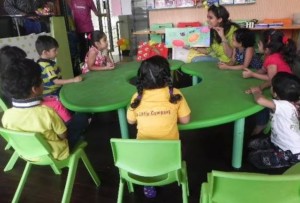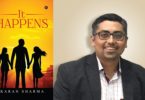Stories have the power to fire up a child’s imagination. They can also help in building up their vocabulary; they are able to comprehend better, their creativity improves, and best of all – the kids become storytellers themselves, quite a holistic way of development for the child. Stories also, very easily, bridge gaps that no other human interaction can hope to achieve.
Sarita Shetty is a story educator at the Bandra, Mumbai center of Little Readers’ Nook. She works as a teacher with an NGO called Vidya. She is a volunteer with Childline in their CSA project, wherein she goes to schools to create awareness among children about child sexual abuse through stories. She conducts various storytelling workshops on voluntary basis, including a recent workshop on storytelling for the English teachers of Mumbai of Bhavishya-Yaan (Vidya NGO).
Here are the excerpts of an exclusive chat we had with Sarita Shetty.
Define yourself – the person, and the storyteller.
When I become the storyteller I tend to forget everything else in my life, and am fully ‘in that moment’. I enjoy telling stories along with my audience; there is a sense of achievement when they get so involved in the story that they look forward to their part in the story and ultimately we all become one with the story. It is wonderful to watch how, at this point, all their inhibitions melt away.
 What influenced you to become a storyteller?
What influenced you to become a storyteller?
My children were the reason I began telling stories, especially with actions and sounds. A big thanks to Devaki Bhujang Gajare, founder of Little Readers’ Nook, who introduced me to professional story telling in October, 2013 and since then I have been in a continuous process of discovering, learning and falling in love with this art.
Tell us about the story of your venture. How did you start it, the challenges faced and how you overcame them?
Initially I was skeptical of my ability to be able to tell stories as a profession. Little Readers’ Nook (LRN) believed in me. I decided to conduct my first workshop for LRN. It was a 5 days back to back workshop. After all the promotions I did for the first storytelling session, which was to be conducted in my house, I had two sweet little listeners in my class, one of them being my own daughter! Nevertheless, I started looking forward to my sessions. It was a huge morale booster when my first student’s mother said, “My daughter waits to come to your class“. They used to travel all the way from Kurla to Bandra (a commute of almost an hour) everyday. Gradually, I started conducting LRN sessions in playschools, in a kids’ play area, and in schools.
What are the kind of audiences you work with? Which is your favorite audience?
The age group of my audience ranges from 3 years to 60 years plus. I enjoy telling stories to all of them. There are no favorites.
Many of my students come up with their own stories which are highly creative and enjoyed by everyone at LRN sessions. I strive to create an environment which is loved by each one of the participants and fondly call it – ‘The Storyland’.
How have the stories in your life influenced your style of storytelling and the way you use stories?
As a little girl whenever I was by myself, if I was not reading books, I would be conversing with nature (I still do!); the wind, the sky, the trees, etc. Or I would make up games with whatever knick-knacks I could find lying around. The habit has stuck with me through the years. Even today I believe everything in this universe has a story to tell, be it a non-living thing or a living being.
Also, I love to listen to people talk; their stories. Each person is trying to tell us a story. We are just not available to hear it. All this reflects in my story telling.
Any particular incident/anecdote from your workshops/sessions that is special to you?
Every one of my story sessions is special to me. Each story session is a story by itself with memories of its own. Recently I conducted a storytelling workshop for children undergoing cancer treatment. After the session, one of the children came and gave me a sheet wherein he had doodled some parts of the story and had written a note…’aapne bahut achi kahani sunaiye’ (‘you told a very nice story’). Such moments are priceless for me. Last month, at a workshop for teachers, one of the teachers commented that she wished she could fit inside a pumpkin and roll down a hill, just like in the story. She experienced being a little girl again.
Any story that you particularly love using?
Stories I tell depend on the audience. Many a times same stories can be told to children as well as adults. But with children I use less of words and more of sounds, actions, songs and visualization. Children take back the songs and hum it. As my amused daughter says, “Amma, I don’t want to sing the song, otherwise the song keeps coming back into my mouth“.
Do you think storytelling can be adopted as a full-time profession? Why?
As I mentioned before all of us are telling stories all the time. Whether it is the bhajiwala, people at the stock market, the weather reporter, the lion, the crow, our spouse, our children, friends. But when we choose to practice storytelling as a profession, with fictional stories, we become the sole source of re-creating all the characters as well as the scene in such a way that the stories come alive for our listeners. It is a challenging profession, but go for it if you feel that storytelling is your calling. It gives immense satisfaction to the teller as well as the listeners.
Your advice to parents and teachers on why and how they should keep stories alive.
Storytelling is the need of the hour, with face-to-face communication being rapidly taken over by technology. We need more and more storytellers on this planet. Parents and teachers play a very important role because stories are the bridge that connect people and storytelling is the live wire for this connection to get established.
—–
Sarita Shetty is a storyteller with Little Readers’ Nook. Read more about Little Readers’ Nook here.
Don’t Miss: We love storytellers as much as we love storytelling. On Tell-a-Tale, lwe’ve featured a lot of talented storytellers, in the past.
Are you a Storyteller? If you’re a storyteller who is actively pursuing storytelling and would like to be featured in this column, drop us a mail at contact AT tell-a-tale.com or reach out to us via Facebook.




